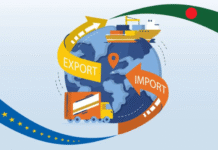
The World Bank predicts a slower economic growth in the current fiscal, but says only 2 percent increase in the rate of employment can make Bangladesh a middle-income country by 2021.
Its lead economist Zahid Hussain on Saturday said lack of agricultural growth, slower manufacturing growth due to weak exports, rising domestic consumption and investment demand, and disruptions in services due to street unrests would keep this year’s growth at 5.8 percent, far below the government’s initial target of 7.2 percent.
Updating journalists about Bangladesh’s economic development at the Bank’s Dhaka office, he, however, termed it ‘still healthy’ compared to Pakistan and Nepal.
The global lender’s Country Sector Coordinator for Bangladesh and Nepal, Salman Zaidi, was also present at the briefing.
According to Hussain, Bangladesh, which made remarkable progress in poverty reduction and MDG achievements in the last two decades, has the ‘historic opportunity’ to be a middle income country by 2021 as the current government wishes by pushing the growth to 8 percent.
“The (8 percent) growth will come by boosting 2 percent employment rate,” he said and that Bangladesh as a ‘Goldman Sachs Next-11’ country had all the potentials to attract investments for generating the required number of employment opportunities.
The economist said in the last five years, Bangladesh’s average growth was 6.1 percent, which was achieved by the ‘growth of labour force participation, productivity and population growth’.
“Employment increased, but the rate has been stagnant. Without employment Bangladesh could achieve 6 percent growth rate, so if the employment rate boosts, the growth will soar,” he said.
He said international and national investors were looking for opportunities in Bangladesh. “East Asia has become expensive, Pakistan is too risky, India is too regulated, Nepal not a well-located country as it’s landlocked and Africa has inadequate production capacity.
“So where the investors will go? Here Bangladesh has the opportunity with its workers’ productivity at par with the Chinese, but costs five times lower than China,” he said.
He said China was outsourcing 80 million jobs in labour-intensive manufacturing sector and Bangladesh, with its 14.2 percent current unemployment rate, had the potential to capture one-fifth of it.
“Bangladesh is well positioned as its legislation offers incentives to investors, duty-free import of capital machinery, bonded warehouses and institutional framework for economic zones in place,” he said and added, “What is needed is to swing into action by removing the ‘decade old-problems’ like access to service land, power and gas shortages and red tape.”
He said Bangladesh’s investment remained stagnant at 25.2 percent which was 6 percent below the Asian norms.
“The Bangladesh Economic Zone Authority has to give 40,000 acres of land for economic zones. The government can give that land from its moribund state-owned enterprises, tea gardens and coastal areas. They will make it service land.
“An additional 5,000 megawatt electricity is needed, along with adequate transport infrastructure, (for 15 million jobs) and for that PPP office should give the responsibility for managing the tendering for infrastructure.
“Bangladesh Bank has to put in place conditions to reduce cost of trade finance following India and China models, and the Board of Investment has to brand Bangladesh before the investors,” he said as he gave ‘agenda for action’ to woo investments.
Despite slower growth, the economist said the inflation target of 7.5 percent was still achievable this fiscal depending on stability in global commodity prices, a functioning domestic supply chain and an unchanged monetary policy.
He said though the current political violence would not create immediate impact on the economic growth, restoration of political stability was ‘a precondition for development’ to move forward with policies and institutional reforms.
Source: Bd news24









